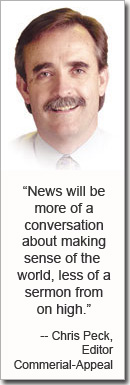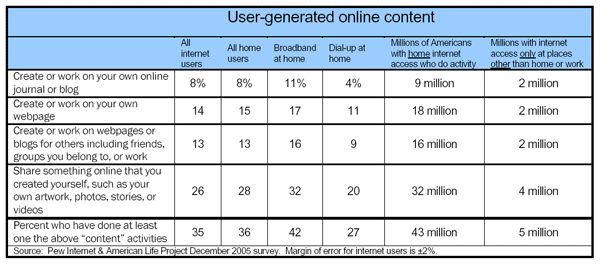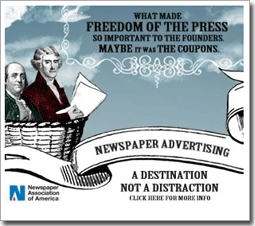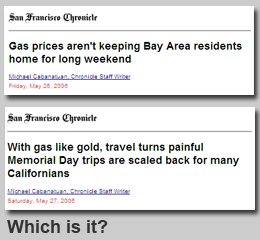May 31, 2006
Follow the (Ad) Money - Online
New advertising spending figures underscore the need for newspaper companies to hasten their path online:
"U.S. Internet advertising surged 38 percent to a record $3.9 billion in the first quarter as marketers moved additional dollars to the Web." - Internet Advertising Bureau
"The internet will overtake national newspapers in the battle for advertising spending in the UK by the end of the year." - The Guardian
John Kotter, the Harvard change management guru, says the first step toward change is conveying a sense of urgency. If I were a newspaper ad executive, or a newsroom executive depending on print ad money to pay my reporters, my gut would be churning from urgency.
(Thanks: I Want Media)
Tags: Journalism, Newspapers, Media
The Conversation About Change Has Changed

![]() "News will be generated by the people who are chosen, not the chosen people."
"News will be generated by the people who are chosen, not the chosen people."
![]() "News will be framed according to your social networks, your age and your tribe."
"News will be framed according to your social networks, your age and your tribe."
![]() "News will rely on the wisdom of the many, not the insight of the few, with journalists being knowledge leaders."
"News will rely on the wisdom of the many, not the insight of the few, with journalists being knowledge leaders."
Those aren't my words, although I agree with them. Neither are they thoughts of any other newspaper industry outsider, like Jarvis or Rosen or Gillmor, all advocates for new forms of journalism to meet the demands of this new age of media.
As you've already guessed because of the accompanying illustration, Chris Peck, editor of the Commercial Appeal in Memphis made those statements in his weekly column (reg. req.).
Various people in and out of newsrooms have been using the "news-is-a-conversation" mantra for a couple of years, but when it comes off the keyboard of a mainstream editor, albeit one known for his thoughtfulness about the profession and passion for good journalism, then I say a tipping point has been reached.
Coming on the heels of Dave Zeeck's speech to ASNE calling for his fellow editors to amp up the leadership they are paid to provide, Peck's manifesto for the future of news indicates a marked shift in the conversation about changing newspapers: The patient has swallowed the bitter pill. It's time to talk about remedies.
The conversation must move from its defensive posture of preserving current newsroom culture and practices to constructive questions that lead to definable goals for change and long-term editorial strategies supported by a commitment to invest in and develop the journalists of the future.
At the APME convention in 2005, Peck, after hearing a panel describe a laundry list of new types of journalism for the future, commented: We need "different brains" and different skills in the newsroom to do those things. Where are we going to get them? In reply I wrote:
"The answer, of course, is we have to grow them - through strategic training, through ongoing learning, through the same sort of professional reinvention other industries have sustained. We must retool the news factory. [Read: Rethinking the News Factory (Again).] The newspaper industry, however, is a training Scrooge, investing on average only 0.7 percent of payroll in professional development, only a third the national average. It has underspent its way into a workforce that is under-prepared for cultural change or professional reinvention. All the good talk and assembled panels about change will amount to naught unless news managers put bodies and dollars into training - about technology, about audience, about communication and collaboration, about leadership." [Read: ASNE to APME: What Happened in Six Months?]
Few newspapers have definable goals for change. Many editors talk about their desire to attract younger readers, to produce brighter writing or to "converge" their newsrooms. Sadly, though, most don't have a true strategy for how to accomplish these things.
Their goals are fuzzy (what does "better writing" mean?) and therefore easily misunderstood (and therefore undermined) by middle-management and staff; their goals are not backed up by resources (moving the bodies to match the goals); their goals don't have measurable outcomes (how much "better writing" do you want? And from whom?).
The conversation must move from the recognition that change is necessary to how do newspapers acquire the tools to accomplish it. What strategies are working at leading-edge papers? What are common obstacles in all papers? What unique challenges does your newsroom have? What are your paper's strengths and weaknesses in facing change, and how can you (and your staff) enhance the former and minimize the latter? What skills does a newsroom leader like Peck need to lead change? What skills does his staff need to assist in that leadership and execute the plan?
The conversation must move from warnings about the industry's arguable doom to developing solutions to the ailments. The Readership Institute is using its web site to display examples of successful change and started a blog to continue that conversation. Go there. Read.
The conversation must move from stagnation to transformation. Yes, newspapers have dug a deep hole for themselves by sitting out (for the most part) the first decade of the digital revolution. But the great news about being a journalist in a dynamic environment is that change is constant so it's always possible to ride the next turn of the wheel.
Peck set two goals for himself other editors should emulate. He wrote (emphasis added):
"First, to work as a translator for my news organization. To help my fellow journalists look ahead to the emerging news ecology and 'take steps now' to adjust our daily work and planning to this new ecology."Second, to strive to be on the leading edge of the transformation. To keep learning about what roles, what jobs 21st-century news organizations are being asked to fill even as the core values of journalism are preserved."
The first is about leadership. The second is about continual learning, both personal and institutional. Both are good conversations to have.
Tags: Journalism, Newspapers, Media
May 30, 2006
People, Enabled, Create and Connect
The latest study from the Pew Internet & American Life provides more evidence that the Internet continues to transform the average person from a media user to a media creator - a trend that should further compel newspapers and other old-form media to hasten their leap across the digital divide.
Pew reports that 48 million Americans - 1 in 3 Internet users - have created and posted online some form of digital content, from blogs to photos to video.
The spreading acceptance of a broadband connection as a mainstream commodity lowers the barrier to entry for personal publishing, says Pew (as does, I would add, the proliferation of social-software sites, e.g., MySpace or Flickr). Here are some bullets from the March study:
Forty-two percent of all American adults had a high-speed internet connection at home - 40 percent more than a year earlier.
The ethnic gap online appears to be shrinking: Broadband adoption among African Americans increased by 121 percent from 2005.
The "broadband elite" is disappearing and content creation is more or less evenly divided by income: In households with less than $50,000 income, 46 percent have posted online; in households of more than $50,000 income, 41 percent.
What this means for journalism is clear:
Further migration of audience to the Web.
More expectation by the public of interactivity, participation and conversation about the news.
More people with the inclination and technical ability to consume broadband news.
More need for news producers (newspapers, e.g.) to publish in multiple formats.
Greater demand in newsrooms for people with online skills.
Here is Pew's chart on content creation:

(Thanks to Steve Yelvington.)
Tags: Journalism, Newspapers, Media
Advertising the Wrong Message
 Steve Outing has it exactly right in panning the Newspaper Association of America's hokey $50 million ad campaign, which seems intended to reinforce the view that newspapers are intended to serve coupon-clipping octogenarians rather than, well, anyone else.
Steve Outing has it exactly right in panning the Newspaper Association of America's hokey $50 million ad campaign, which seems intended to reinforce the view that newspapers are intended to serve coupon-clipping octogenarians rather than, well, anyone else.
Outing writes (emphasis added):
"The old-fashioned, Rube Goldberg-esque ads send exactly the wrong message. How about a campaign that emphasizes the power of print plus online; that shows how newspapers are no longer about print dominance and have some of the strongest websites on the Internet; that show that newspapers understand the Internet, embrace it, and aren't fighting it?"
The NAA ads are defensive, highlighting the past rather than the future. Even the slogan takes a swipe at the dynamics of newer media - A Destination, Not a Distraction.
Outing also points to the report last week by Merrill Lynch analysts on the outlook for newspaper economics. The title of the report says it all: "DEEP Depressing Dive."
Analyst Lauren Fine not only sees newspaper ad revenue this year rising at less than the rate of inflation (only 1.2 percent), but warns that to compensate for the loss of print revenue newspaper companies are "being too aggressive with their online pricing," meaning these companies, which are accustomed to obese margins in print are trying to transfer the same pricing power to the Web.
It's greedy, Fine implies, and it won't work because newspapers' digital competitors "are either not charging or charging lower prices as they seem more motivated to use the traffic being generated by the listings to offer other wraparound services." In other words, they're more interested in building audience first, then revenue.
Newspaper revenue is not going to keep pace with costs. With more and more advertisers opting for Web over print, newsrooms can expect more editorials cuts. [Read: Classifieds Shift Online and Da Vinci, Da Movies, Da Money, Da Lost Opportunity.]
The business model is failing, the editorial model is losing relevance. I've said it before:; I'll say it again: Reinvent or die. [Read: If Newspapers Are to Rise Again.]
Fine says the same thing her way: "I have not completely lost faith, but I still think the economic climate is going to be challenging ... the point is that newspapers need to change."
Tags: Journalism, Newspapers, Media
May 29, 2006
Da Vinci, Da Movies, Da Money, Da Lost Opportunity
![]() "Here's the gospel on The Da Vinci Code: It's a total snore." - Detroit News
"Here's the gospel on The Da Vinci Code: It's a total snore." - Detroit News
![]() "The most controversial thriller of the year turns out to be about as exciting as watching your parents play Sudoku." - Washington Post
"The most controversial thriller of the year turns out to be about as exciting as watching your parents play Sudoku." - Washington Post
![]() "How can a film contain so many clues yet remain utterly clueless?" - Chicago Tribune
"How can a film contain so many clues yet remain utterly clueless?" - Chicago Tribune
![]() "Plodding, tedious, deathly dull." - Philadelphia Inquirer
"Plodding, tedious, deathly dull." - Philadelphia Inquirer
![]() "A melodramatic, sometimes lifeless film." - USA Today
"A melodramatic, sometimes lifeless film." - USA Today
The newspaper critics hated it. The public loves it. What would you think if you were a Hollywood exec? Who needs the critics, right?
That's David Carr's point today in his New York Times column - Hollywood is increasingly skipping the traditional pre-screening of movies for press critics because it sees the Web as a more powerful, more influential tool to attract movie audiences. The bad news for newspapers is not just the dissing of their (usually) well-paid critics, but the accompanying loss of ad money.
Hollywood spends $1 billion a year on newspaper advertising, Carr says, but more and more of that money is headed elsewhere - most to the Net. He reports:
"The industry cut back newspaper advertising last year - down $60 million compared with the year previous - the first time in five years, according to TNS Media Intelligence, a market research firm."
(TNS also reported that general retail advertising, upon which newspapers depend heavily - those big department store ads - fell 1.1 percent in 2005, a year in which the overall ad spend rose 3 percent. Overall advertising spending on newspapers did rise last year, but only 1.1 percent - less than the rate of inflation - while spending on cable TV and Internet advertising grew 11.4 and 13.3 percent, respectively.)
Enough numbers. You get the point. A core newspaper advertiser - the Hollywood entertainment complex - is increasingly seeing newspapers as irrelevant to its primary business: Filling theater seats.
This is the issue newspapers face on all fronts: Relevancy. The competition for audience is not about news, not about the quality of journalism, not even about whether the great unwashed cares more about Branjelina than global warming, but the relevancy of the medium to the lives people lead.
And, the battleground for that competition is digital.
As recently as 2001, a year after some of the biggest companies in Hollywood formed Fandango, the theater ticket direct seller that bypasses a consumer's need to look in a newspaper for movie locations and times, the newspaper industry still had its head buried in a bucket of buttered popcorn about entertainment advertising dollars. Here's Presstime magazine, the house organ of the Newspaper Association of America, reporting on a panel at the group's annual convention:
"The idea that newspaper movie advertising is becoming obsolete was reduced to an unsubstantiated myth."
Uh-huh. Sure. Yeah, that's right. Compare that with this item from Carr's column:
"Back when he first took hold of the newly formed AOL Time Warner, Steve Case talked of a holy grail in which companies could open movies without buying significant print ads. That never came to pass, but now a new division of Fox Film Entertainment aimed at teenagers, Fox Atomic, will produce eight films a year with a print budget of exactly zero."
Print advertising for newspapers will soon be reduced to ego-feeding posters that celebrate awards season. The message is clear: The conversation about entertainment - just as the one about news - has moved on while newspapers stood still. Influence - and relevance - today belongs to those enable (and guide) conversation, not to those who tell everyone else what to think.
Credit: Opening blurbs via Rotten Tomatoes.
Tags: Journalism, Newspapers, Media, Da Vinci Code
May 27, 2006
The Gas is Half Full -- or Half Empty
Few stories produced are hoarier than the ritual holiday travel piece, a slapdash amalgam of quotes from on-the-one-hand-on-the-other "experts," worried or elated industry officials and a random selection of ordinary people who happened to be pumping gas or standing in a ticket line when a reporter and a photographer showed up.
 They are the worse sort of tired, cliché-ridden journalism, emblematic of all the rote thinking that not only wastes valuable newsroom resources on copy designed to fill white space but too often also has the unintended result of confusing the very person the paper is supposed to be informing - the reader.
They are the worse sort of tired, cliché-ridden journalism, emblematic of all the rote thinking that not only wastes valuable newsroom resources on copy designed to fill white space but too often also has the unintended result of confusing the very person the paper is supposed to be informing - the reader.
As the Memorial Day weekend begins, these stories proliferate like May flowers. It is almost unfair to pick on individual papers, but let's do it anyway.
The inspiration for this post arrived with today's New York Times and San Francisco Chronicle. Scanning their front pages at the breakfast table, two headlines caught my eye:
![]() Gas Prices Aren't Deterring Summer Travelers - the Times
Gas Prices Aren't Deterring Summer Travelers - the Times
![]() With gas like gold, travel turns painful / Memorial Day trips are scaled back for many Californians - the Chronicle
With gas like gold, travel turns painful / Memorial Day trips are scaled back for many Californians - the Chronicle
Hmmm. So people are traveling more, according to the Times headline, or less, according to the Chronicle. Confusing. Let's read the stories (emphasis added):
"A new survey predicts that even more Californians plan to hit the road this weekend on trips of 50 miles or more. But while the number of motoring travelers is increasing, many Northern Californians say that gas prices at $3.25 a gallon are forcing them to stick closer to home." - the Chronicle."People are not going to cancel their trips, but what they might do is modify them," said Cathy Keefe, a spokeswoman for the Travel Industry Association. "Instead of taking three or four trips over the summer, people will look for ways to save money, such as staying closer to home." - the Times.
Aha. People are actually driving more, but not as far, according to the Times and the Chronicle.
But if the stories say the same thing, why are the headlines different? Let's double check that on the web. Here's a headline from the Chronicle on Friday:
Gas prices aren't keeping Bay Area residents home for long weekend - the Chronicle.
Wait a minute, that Chronicle's Friday story - posted on its web site mid-afternoon - is the same as its Saturday story - printed in the newspaper, but with a headline that is almost 180 degrees different. Here they are again, same story, different heads (see image, left):
Friday: Gas prices aren't keeping Bay Area residents home for long weekend
Saturday: With gas like gold, travel turns painful / Memorial Day trips are scaled back for many Californians
A scan of Google News or the Newseum's newspaper front pages produces a plethora of similar wishy-washy stories - maybe this, maybe that, could be, possibly, who knows? Hardly at all useful use of reporter time or newsprint. Here are a couple of examples:
Holiday weekend is still a gas / Despite cost of fuel, travel experts expect increase in road trips - Corpus Christi Caller-Times
On the road again -- but not very far - Santa Barbara News Press
Costs up, but people still travel for holiday -- Sioux City (Iowa) Journal
Drivers, start your engines / Record gasoline prices not keeping millions from yearly ritual - San Diego Union-Tribune (on the N.Y. Times story)
And, possibly the most honest:
Analysts up and down about holiday weekend gas prices - Palm Beach Post
Nearly every story I saw was based in part on a AAA press release. Why turn this equivocal drivel into a story at all? It's a box in the paper with prices, data and numbers. On the web, it's links. Five minutes work and move on to something better - something unique, something the paper and the staff hasn't done 150 times before.
Clichés kill. They kill good writing, They kill good ideas. They kill innovation. They are killing newspaper journalism.
It's time to bury them.
Tags: Journalism, Newspapers, Media
May 16, 2006
At Last - Leadership
The pixels were barely dry one of First Draft's last pre-hiatus posts - one about the continuing lack of forward-looking leadership in the newspaper industry - when events did what events always do to that which remains static - made its point out of date.
My response to those events is equally behind the times because I wanted to let a sleeping blog lie for a bit longer, but as I think about how critical leadership is to change I couldn't let this thought go, even at the risk of appearing to be slower off the news than a wire service feature story.
Before this year's ASNE convention (a fading memory for most, I'm sure), I applauded the group's inclusion of panels on innovation and change, subjects it all but ignored the previous year, but pointed out that assembled editors were still not focusing on the one thing that is not only necessary for reinvention of newspapers in a digital age but is also their primary job: Leadership.
I wrote:
"If we are going to reinvent newspapers - and we are - we must reinvent the leadership of newspapers. The traditional top-down, opaque, defensive style of management found in most newsrooms cannot foster a new future."
As it turned out, someone at ASNE was thinking exactly as I was - Dave Zeeck, editor of the Tacoma News Tribune and incoming ASNE president. Zeeck spoke to the convention on its last day, after I had already flown home to San Francisco. Zeeck said he is "not spending another minute of my life worrying about the future of newspapers," that it is the news that matter, the journalism, not the platform. [Read: There's Nothing Left but the Journalism.] And, said Zeeck, the future of news will depend greatly on how it is shaped - or ignored - by today's newsroom managers. He said (emphasis added):
"Our choice couldn't be clearer. We can be swept along by a tide of change - a blizzard of technology, news as a commodity, multiplying competitors, the pressures of Wall Street and limited resources."Or we can take who we are - experienced journalists, critical thinkers, people of integrity, skilled at asking good questions and analyzing data - and exert our energies and our talents to craft the best outcomes that we can imagine and deliver.
"Merely riding the current of change, complaining all the while, is a path that leads only to cynicism and failure. It's seductively self-indulgent, but it's just plain wrong.
"The alternative is choosing to act. That's leadership. And it's what these times demand."
Zeeck outlined a leadership agenda, one I think makes a great deal of sense and can used as a foundation for change in newsrooms large and small. Among the bullet points:
Leadership on quality: "We must give readers leadership that produces more journalism worthy of the First Amendment."
Leadership on transparency - inside and outside the newsroom: "It means keeping our word, and correcting our mistakes. It means protecting and living by the values we hold sacred."
Leadership on connecting to community: "�talk to your community - regularly and honestly. We owe them frank discussion of our strengths and limitations, our aspirations and our failures."
Telling, of course, is not teaching; and, talking certainly is not doing. The current crop of newspaper editors must learn a new set of leadership skills. That means investment in professional development and likely a culling out of those who can't make the transition from a role of managing the past to inventing an uncertain future. Still, Zeeck's call to action - frankly, in my view, a call for the end of the managerial status quo and a reinvigoration of the aging upper rungs of the newsroom hierarchy - is significant because he is, for the coming year at least, the visible voice of the traditional press and at last this voice, which has spent two decades speaking plaintively outward about changes in demographics, the rise of technology and the loss of readership, is speaking in the right direction - inward, to those being paid to produce quality journalism in difficult circumstances.
I hear Zeeck saying: It's your job, it's our job. It's time to exchange complaceny for urgency. In his words: "We didn't ask for these times, but they're the ones we're given. � Let's get to work."
Tags: Journalism, Newspapers, Media